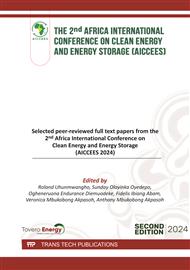p.121
p.141
p.155
p.165
p.175
p.195
p.205
p.227
p.245
A Framework for Sizing Solar PV Systems Adaptable to Off Grid Areas
Abstract:
Solar PV sizing is the process of determining the quantity and capacity of solar PV system components to meet a given energy demand. This process is needed to ensure that the components are not undersized resulting in insufficient energy or oversized increasing the system cost. This study has reviewed seven solar PV sizing frameworks currently in use in the market including intuitive frameworks, numerical, and analytical frameworks. However, these frameworks have neglected some key adaptability factors unique to off-grid areas such as the ability of the household to pay, the roofing structure, and the ability of the system to be relocated. This neglect has seen development of solar PV systems that are beyond the budget of most households in off-grid areas and with specifications that technically inhibit their effective use in the off-grid setup. Therefore, for enhanced adaptability, there is need to develop a new solar PV sizing framework that considers the unique adaptability factors of off grid areas. This study identified these unique adaptability factors and categorized them as economic, technical, location and mobility factors. The study further investigated how these factors influence the size of a solar PV system and revealed that economic, factors of income and system cost play a major role in sizing an adaptable solar PV system. Demand as a technical factor was also found to significantly influence the system size while temperature and irradiation as location factors were found to be significant when comparing systems that need to be used in different geographical areas. Mobility factors such system type was revealed to influence the adaptation of the PV system in nomadic setups. Through the modification of the existing numerical sizing framework, these adaptability factors were integrated in the sizing process within the context of this study. It was established that by integrating these factors, the resultant PV systems were more adaptable to off-grid areas in terms of cost, mobility, durability and reliability.
Info:
Periodical:
Pages:
175-191
Citation:
Online since:
February 2025
Authors:
Keywords:
Price:
Сopyright:
© 2025 Trans Tech Publications Ltd. All Rights Reserved
Share:
Citation:


